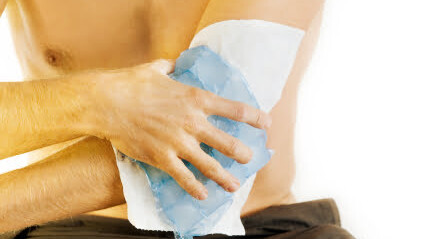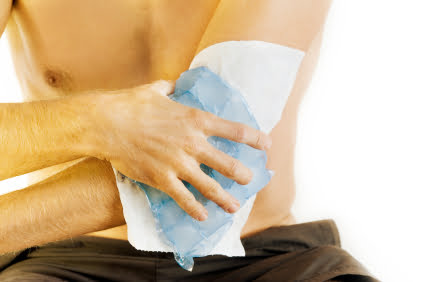
Most people realise that applying ice to an acute injury is the correct choice. However after this initial application of ice to an injury, we tend to find many and varied methods are used thereafter. It is very important when applying temperature therapy to get it right, as the wrong choice may aggravate the injury.
Cold Therapy
 Cold therapy with an ice pack is the best way to treat an acute injury in its early stages. Acute injuries are defined as sudden and traumatic injuries that develop instantly (or very quickly) after a specific causative event such as a collision, direct contact, or sprain. Ice is a vaso-constrictor (meaning it constricts the blood vessels). Most acute injuries will have some form of bleeding response, so the ice is critical to reduce the blood flow to the injured area as soon as possible after the injury occurs. Reducing the bleeding reduces the damage to the surrounding tissue. Ice also has the added benefit of easing pain. So what is the best method for managing your acute injury with ice?
Cold therapy with an ice pack is the best way to treat an acute injury in its early stages. Acute injuries are defined as sudden and traumatic injuries that develop instantly (or very quickly) after a specific causative event such as a collision, direct contact, or sprain. Ice is a vaso-constrictor (meaning it constricts the blood vessels). Most acute injuries will have some form of bleeding response, so the ice is critical to reduce the blood flow to the injured area as soon as possible after the injury occurs. Reducing the bleeding reduces the damage to the surrounding tissue. Ice also has the added benefit of easing pain. So what is the best method for managing your acute injury with ice?
Ice cubes held in a specific container, or wrapped in a layer of cloth or towel is the best way. The ice is placed directly over the injury, and keep in mind the following tips:
- Ice should be applied for a maximum of 20 minutes – more is not better, and icing for over 30 minutes at a time can cause damage to the skin, such as frostbite or ice burns.
- Ice regularly – for injuries that are swollen and painful, ice for 20 minutes every two hours. Sometimes for very bad injuries we encourage icing for 20 minutes every hour for the initial day.
- Don’t ice just once! This is the most common mistake we hear of on a Monday morning at SSPC. If the injury is swollen, it will need more than one application of ice. Many acute sporting injuries need icing for at least 48 hours after the injury.
- Check the skin, particularly in children, during the icing process. Make sure no localised white areas of skin are showing amongst the general redness that ice produces – this can indicate tissue damage and burning.
The benefits of cold therapy are routinely used by all AFL clubs. It is common to see the players immediately after games “icing down” and many players return immediately to their clubs to use the ice baths. Players are then seen at the beach the next day, which is a brilliant management strategy for acute injuries – the salt water provides not only cold therapy, but also compression, and reduction of swelling through the osmosis process which is related to the salt content of the water.
Heat Therapy
Heat therapy is used for chronic injuries,or injuries that have been around for a while, and show no signs of inflammation or swelling. Heat therapy increases circulation and raises skin and muscle temperature, so it is great to use as a warm up before an event, particularly on stiff and tight muscles and joints. Never apply heat directly after an acute injury, and don’t fall into the common trap of icing after an injury, but then going home for a nice hot 30 minute bath! Keep in mind the following tips for using heat therapy:
- Never apply heat if there is any signs of swelling, or if your injury has just occurred.
- As with ice, apply heat for no greater than 20 minutes, and regularly check the skin for signs of a burn. Ensure you place towels or layers between a hot pack and your skin.
- Don’t apply heat after exercise – even if your injury is chronic, ice is best used after exercise as it is likely that post event discomfort is at least partly related to inflammation or swelling.
- When heating wheat bags (which are brilliant for heat therapy), place a mug half full of water in the microwave with the bag – this is safer and prolongs the lifespan of your wheat bag.
- Never fall asleep whilst applying heat therapy – this a sure fire way to end up with a burn!
Don’t forget that for chronic injuries, massage is also a great way of applying direct and deep heat therapy to a muscle or tendon.
We have a fantastic new ice pack available at SSPC which is on special for the next month, along with wheat bags of all shapes and sizes.
You might like these other resources
Why Do My Joints Ache In Cold Weather?
11 June 2025
The Role of Ice in Managing Acute Sporting Injuries
17 September 2024
Are Your Bones Strong Enough?
28 May 2024





